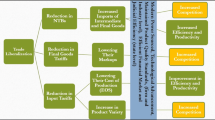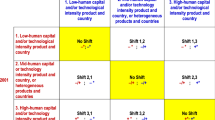Abstract
After nearly two decades of trade restrictions, Tanzania launched a series of trade liberalization measures in the mid 1980s. Economic and manufacturing growth, which had collapsed in the ‘crisis years’ prior to liberalization, recovered modestly thereafter. This chapter examines the extent to which manufacturing firms responded technologically to trade liberalization, and whether their performance in the post-liberalization period can be explained in terms of their relative technological efforts and capabilities. It also sheds light on micro-level supply-side factors that determined the capacity of firms to upgrade technology and improve economic performance under the conditions of trade liberalization. The analysis deals with two subsectors — engineering and garments — and is based on a cross-section survey of 65 firms.
The authors wish to thank R. Kulwa, L. Luvanga and M. Sanghe for participating in the field research.
Access this chapter
Tax calculation will be finalised at checkout
Purchases are for personal use only
Preview
Unable to display preview. Download preview PDF.
Similar content being viewed by others
Editor information
Editors and Affiliations
Copyright information
© 1999 The United Nations University
About this chapter
Cite this chapter
Deraniyagala, S., Semboja, H.H.H. (1999). Trade Liberalization, Firm Performance and Technology Upgrading in Tanzania. In: Lall, S. (eds) The Technological Response to Import Liberalization in SubSaharan Africa. Palgrave Macmillan, London. https://doi.org/10.1007/978-1-349-14852-3_4
Download citation
DOI: https://doi.org/10.1007/978-1-349-14852-3_4
Publisher Name: Palgrave Macmillan, London
Print ISBN: 978-1-349-14854-7
Online ISBN: 978-1-349-14852-3
eBook Packages: Palgrave Economics & Finance CollectionEconomics and Finance (R0)




